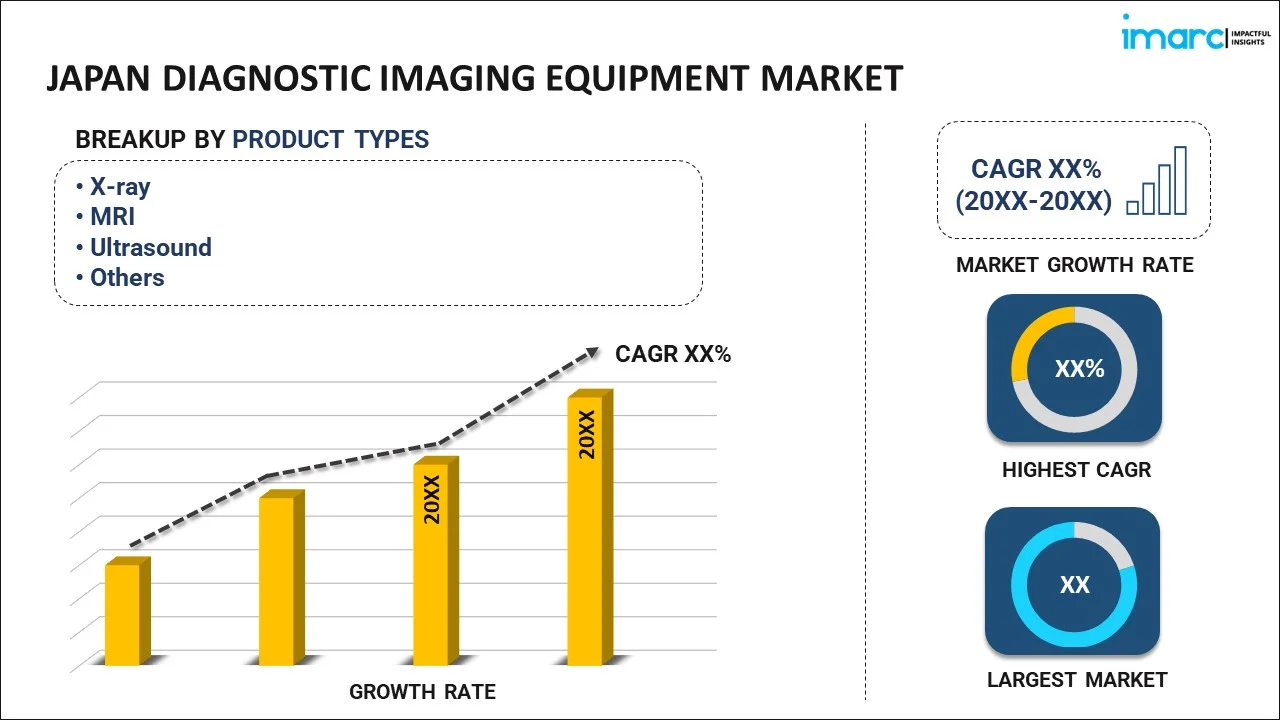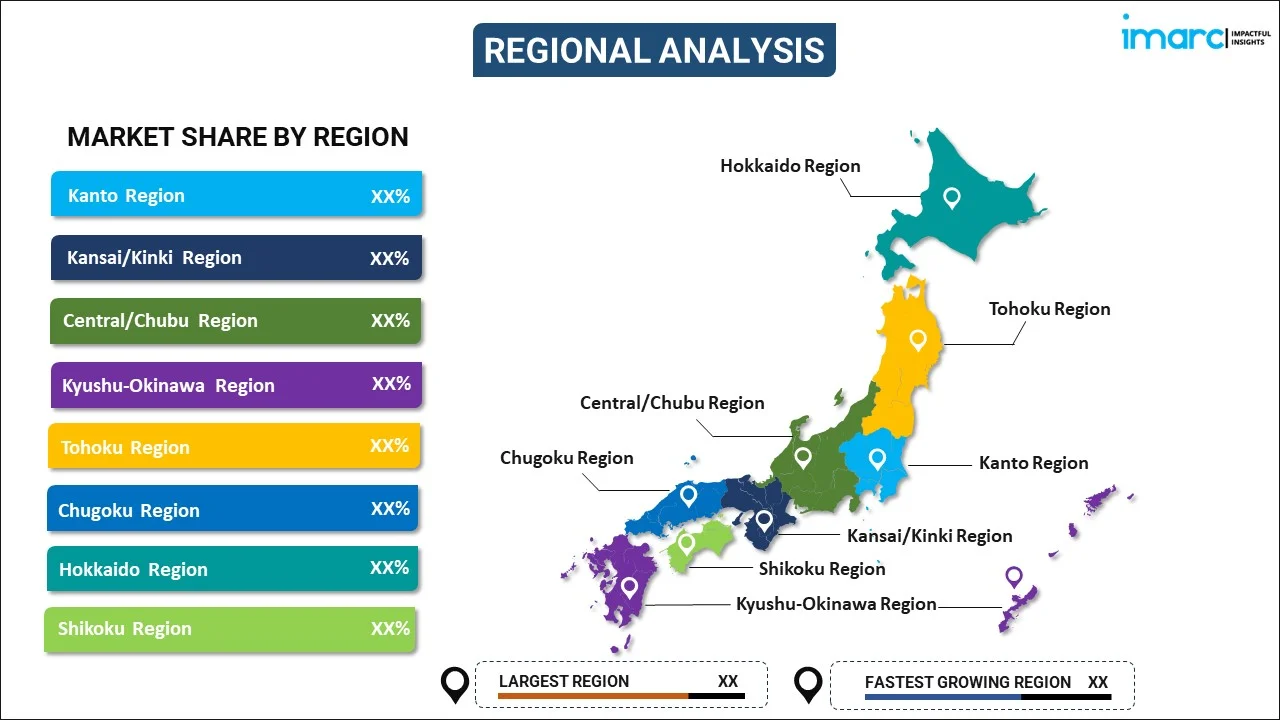
Japan Diagnostic Imaging Equipment Market Report by Product Type (X-ray, MRI, Ultrasound, Computed Tomography, Nuclear Imaging, and Others), Application (Cardiology, Oncology, Neurology, Orthopedics, and Others), End User (Hospitals, Diagnostic Centers, and Others), and Region 2025-2033
Market Overview:
Japan diagnostic imaging equipment market size reached USD 2.1 Billion in 2024. Looking forward, IMARC Group expects the market to reach USD 3.6 Billion by 2033, exhibiting a growth rate (CAGR) of 6.2% during 2025-2033. The growing prevalence of chronic conditions, coupled with an aging global population and continuous advancements in imaging technologies, is primarily driving the demand for diagnostic imaging equipment.
|
Report Attribute
|
Key Statistics
|
|---|---|
|
Base Year
|
2024
|
|
Forecast Years
|
2025-2033
|
|
Historical Years
|
2019-2024
|
|
Market Size in 2024
|
USD 2.1 Billion |
|
Market Forecast in 2033
|
USD 3.6 Billion |
| Market Growth Rate 2025-2033 | 6.2% |
Diagnostic imaging equipment play a crucial role in modern healthcare, enabling the non-invasive visualization of the structure and function of the body to diagnose, monitor, and treat medical conditions effectively. They span a diverse array, including MRI machines, CT scanners, X-ray machines, ultrasound systems, and nuclear imaging systems. Each type offers unique insights, with some specializing in detailed structural images, while others excel in portraying functional activity within the body. The advent of these technologies has marked a pivotal transition in medical diagnostics, allowing for earlier and more accurate detection of abnormalities, thus facilitating timely and targeted interventions. They aim to increase the accuracy and efficiency of diagnosis and assessment, thereby optimizing patient outcomes and contributing significantly to the progress of medical science and healthcare delivery.
Japan Diagnostic Imaging Equipment Market Trends:
The diagnostic imaging equipment market in Japan is experiencing substantial growth, influenced by several drivers and trends. A key factor is the expanding aging population, which necessitates advanced healthcare solutions and services, including enhanced diagnostic imaging for early detection and management of chronic and age-related diseases. The country’s sustained focus on technological innovation is facilitating the development and adoption of advanced imaging technologies, enabling more precise and detailed diagnostics. Additionally, the integration of artificial intelligence and advanced computing in imaging technologies is a prevailing trend, improving image analysis and interpretation, thus aiding in more accurate and timely diagnosis. The increasing investment in healthcare infrastructure and research & development activities are bolstering the availability and adoption of cutting-edge diagnostic imaging equipment in Japan. Moreover, the government’s supportive policies and initiatives are fostering a conducive environment for the growth of the diagnostic imaging equipment market. The market is also benefiting from a consumer base that is highly health-conscious and values preventative healthcare measures. The ongoing advancements in imaging modalities, the growing preference for minimally invasive diagnostic procedures, and the continuous improvement in healthcare facilities are pivotal in steering the diagnostic imaging equipment market in Japan towards further expansion and sophistication.
Japan Diagnostic Imaging Equipment Market Segmentation:
IMARC Group provides an analysis of the key trends in each segment of the market, along with forecasts at the country level for 2025-2033. Our report has categorized the market based on product type, application, and end user.
Product Type Insights:

- X-ray
- MRI
- Ultrasound
- Computed Tomography
- Nuclear Imaging
- Others
The report has provided a detailed breakup and analysis of the market based on the product type. This includes x-ray, MRI, ultrasound, computed tomography, nuclear imaging, and others.
Application Insights:
- Cardiology
- Oncology
- Neurology
- Orthopedics
- Others
A detailed breakup and analysis of the market based on the application have also been provided in the report. This includes cardiology, oncology, neurology, orthopedics, and others.
End User Insights:
- Hospitals
- Diagnostic Centers
- Others
The report has provided a detailed breakup and analysis of the market based on the end user. This includes hospitals, diagnostic centers, and others.
Regional Insights:

- Kanto Region
- Kansai/Kinki Region
- Central/ Chubu Region
- Kyushu-Okinawa Region
- Tohoku Region
- Chugoku Region
- Hokkaido Region
- Shikoku Region
The report has also provided a comprehensive analysis of all the major regional markets, which include Kanto Region, Kansai/Kinki Region, Central/ Chubu Region, Kyushu-Okinawa Region, Tohoku Region, Chugoku Region, Hokkaido Region, and Shikoku Region.
Competitive Landscape:
The market research report has also provided a comprehensive analysis of the competitive landscape in the market. Competitive analysis such as market structure, key player positioning, top winning strategies, competitive dashboard, and company evaluation quadrant has been covered in the report. Also, detailed profiles of all major companies have been provided.
Japan Diagnostic imaging equipment Market Report Coverage:
| Report Features | Details |
|---|---|
| Base Year of the Analysis | 2024 |
| Historical Period | 2019-2024 |
| Forecast Period | 2025-2033 |
| Units | Billion USD |
| Scope of the Report | Exploration of Historical Trends and Market Outlook, Industry Catalysts and Challenges, Segment-Wise Historical and Future Market Assessment:
|
| Product Types Covered | X-ray, MRI, Ultrasound, Computed Tomography, Nuclear Imaging, Others |
| Applications Covered | Cardiology, Oncology, Neurology, Orthopedics, Others |
| End Users Covered | Hospitals, Diagnostic Centers, Others |
| Regions Covered | Kanto Region, Kansai/Kinki Region, Central/ Chubu Region, Kyushu-Okinawa Region, Tohoku Region, Chugoku Region, Hokkaido Region, Shikoku Region |
| Customization Scope | 10% Free Customization |
| Post-Sale Analyst Support | 9-11 Weeks |
| Delivery Format | PDF and Excel through Email (We can also provide the editable version of the report in PPT/Word format on special request) |
Key Questions Answered in This Report:
- How has the Japan diagnostic imaging equipment market performed so far and how will it perform in the coming years?
- What has been the impact of COVID-19 on the Japan diagnostic imaging equipment market?
- What is the breakup of the Japan diagnostic imaging equipment market on the basis of product type?
- What is the breakup of the Japan diagnostic imaging equipment market on the basis of application?
- What is the breakup of the Japan diagnostic imaging equipment market on the basis of end user?
- What are the various stages in the value chain of the Japan diagnostic imaging equipment market?
- What are the key driving factors and challenges in the Japan diagnostic imaging equipment?
- What is the structure of the Japan diagnostic imaging equipment market and who are the key players?
- What is the degree of competition in the Japan diagnostic imaging equipment market?
Key Benefits for Stakeholders:
- IMARC’s industry report offers a comprehensive quantitative analysis of various market segments, historical and current market trends, market forecasts, and dynamics of the Japan diagnostic imaging equipment market from 2019-2033.
- The research report provides the latest information on the market drivers, challenges, and opportunities in the Japan diagnostic imaging equipment market.
- Porter's five forces analysis assist stakeholders in assessing the impact of new entrants, competitive rivalry, supplier power, buyer power, and the threat of substitution. It helps stakeholders to analyze the level of competition within the Japan diagnostic imaging equipment industry and its attractiveness.
- Competitive landscape allows stakeholders to understand their competitive environment and provides an insight into the current positions of key players in the market.
Need more help?
- Speak to our experienced analysts for insights on the current market scenarios.
- Include additional segments and countries to customize the report as per your requirement.
- Gain an unparalleled competitive advantage in your domain by understanding how to utilize the report and positively impacting your operations and revenue.
- For further assistance, please connect with our analysts.
 Inquire Before Buying
Inquire Before Buying
 Speak to an Analyst
Speak to an Analyst
 Request Brochure
Request Brochure
 Request Customization
Request Customization




.webp)




.webp)












